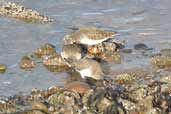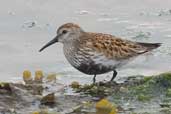
The Dunlin breeds around the Arctic Ocean in Europe (including the British Isles), Asia and North America but winters further south on ice-free coasts but rarely crosses the Equator.

Its small size can be judged against the Redshank Tringa totanus seen on the right of the second photo. This bird is a juvenile showing a gingery tinge to the head and mantle and rather bold, black spots on the side of the belly.

In the breeding season it prefers boggy ground, coastal grasslands and salt-marshes provided there is water nearby.

In summer, see photos 3 to 6, it has a distinctive black patch on the belly as well as rufous on the mantle.






| Previous Page | Back to Index | Next Page |